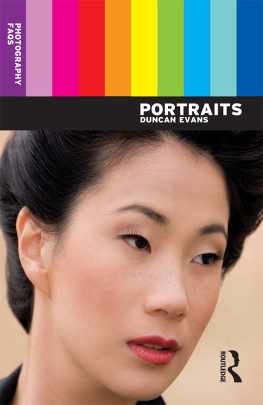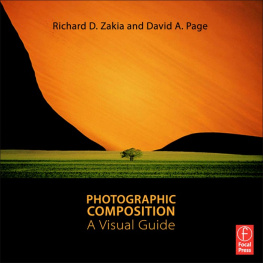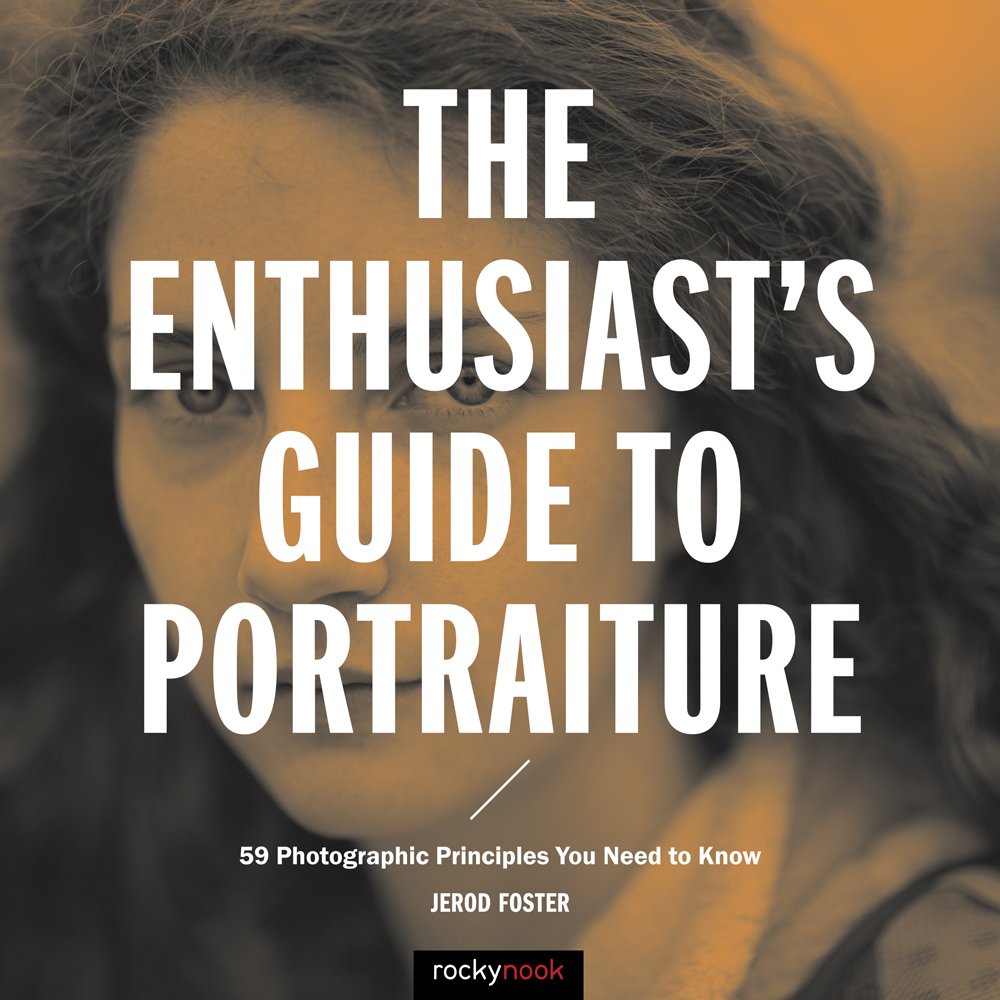
THE
ENTHUSIASTS
GUIDE TO
PORTRAITURE

59 Photographic Principles You Need to Know
JEROD FOSTER

THE ENTHUSIASTS GUIDE TO TO PORTRAITURE:
59 PHOTOGRAPHIC PRINCIPLES YOU NEED TO KNOW
Jerod Foster
Project editor: Maggie Yates
Project manager: Lisa Brazieal
Marketing manager: Jessica Tiernan
Layout and type: WolfsonDesign
Design system and front cover design: Area of Practice
Front cover image: Jerod Foster
ISBN: 978-1-68198-138-3
1st Edition (1st printing, November 2016)
2016 Jerod Foster
All images Jerod Foster unless otherwise noted
Rocky Nook Inc.
1010 B Street, Suite 350
San Rafael, CA 94901
USA
www.rockynook.com
Distributed in the U.S. by Ingram Publisher Services
Distributed in the UK and Europe by Publishers Group UK
Library of Congress Control Number: 2016930703
All rights reserved. No part of the material protected by this copyright notice may be reproduced or utilized in any form, electronic or mechanical, including photocopying, recording, or by any information storage and retrieval system, without written permission of the publisher.
Many of the designations in this book used by manufacturers and sellers to distinguish their products are claimed as trademarks of their respective companies. Where those designations appear in this book, and Rocky Nook was aware of a trademark claim, the designations have been printed in caps or initial caps. All product names and services identified throughout this book are used in editorial fashion only and for the benefit of such companies with no intention of infringement of the trademark. They are not intended to convey endorsement or other affiliation with this book.
While reasonable care has been exercised in the preparation of this book, the publisher and author assume no responsibility for errors or omissions, or for damages resulting from the use of the information contained herein or from the use of the discs or programs that may accompany it.
This book is printed on acid-free paper.
Printed in China
To my students,
who keep pushing me as much as I push them.

ACKNOWLEDGEMENTS
IMMENSE THANKS goes out to many folks for helping put this book together. So many people gave their time and talents to ensure this project came off without a hitch.
First and foremost, I must thank my family. My wife, Amanda, and two daughters, Eva and Lola Mae, know the life of a traveling photographer all too well, and Ill never be able to repay them the time Ive missed while out on the road chasing this dream and career. They are a continual source of inspiration and influence and the very definition of patience. I love you with all of my heart!
Great thanks goes out to the fine folks at Rocky Nook for allowing me to play an integral role in the development of the new Enthusiasts Guides. Thank you all for letting me be a part of the team! Thanks to Ted Waitt, who invited me to join Alan Hess and Khara Plicanic in writing these first books for the series. Also, many thanks to Maggie Yates, whose outstanding contribution to the project ensured the text and content you see in the following pages is both relevant and comprehensible. Finally, many thanks to Lisa Brazieal, whose book production management once again resulted in a great-looking text!
Additionally, thank you to my colleagues and administration at Texas Tech University. My time as a photography and electronic media professor at the College of Media and Communication has been one of excitement, challenge, and growth. I cant think of a more supportive group to push my work, both in and out of the classroom. Specifically, thanks goes to Drs. Rob Peaslee, Todd Chambers, and David Perlmutter for your guidance and encouragement through the years. Im fortunate to call you colleagues and friends.
Lastly, I would like to thank my students and friends who have supported me and/or played a role in helping put this book together. Im fortunate to play roles as an educator and a professional, and my students allow me great flexibility and openness in bringing the real world into the classroom. They are a great inspiration for many of the books Ive written. Specifically, I would like to thank Simon Parmley, Torico Price, Laurie Tolboom, Anna Claire Beasley, Demi Cole, Abbie Burnett, Tate Leatherwood, Lynley Lewis, Alyssa Peden, Lauren Purser, Allison Reid, Hannah Turner, Hope Hancock, and Justin Rex. Many thanks for your integral contribution to the books. Photography, as individualistic as it seems on the surface, is indeed a collaborative effort.
CONTENTS


INTRODUCTION
INTRODUCTION
Portraiture is a large subject. Its a historical way of making art, and an enormous part of the modern photography industry. Its an important part of both photography and society in general. The fact that youve picked this book up is a testimony to how attractive making portraits can be, and I welcome you to this essential aspect of your craft and art as a photographer.
As part of the Enthusiasts Guide series of books from Rocky Nook, I want to highlight what this book is and what it is not. It is first and foremost a guide: it provides you useful, practical, take-to-the-bank tips, considerations, and best practices for your adventure into portrait photography. It is efficient, allowing you to study certain concepts or techniques briefly and quickly actualize them in your own work.
Finally, it is a starting point, a way of grounding your portraiture worka platform from which you can grow your photographic creativity and proficiency. These are the pieces of information that I take with me every time I shoot a portrait, whether its on assignment or at a family gathering, and I believe they can be useful for your work as well.
Conversely, this book is not a technical manual. Although one chapter is completely devoted to setting up your camera, and other chapters include technical detailsaperture/depth of field considerations, focal length choice, and the likeits not my goal to teach you about your camera (although I believe youll pick up a thing or two). My goal is to move you beyond thinking about the camera more than thinking about the image youre making. Its helpful to have a fairly good understanding of your camera in order to put many of the following tips and techniques to practice for your portraiture.
Additionally, the book is not one centered on a specific type of portraiture. It does not look at only family portraiture, or wedding/engagement portraiture, or even editorial environmental portraiture. Instead, it highlights information that can be employed in all types of portraiture. Youll see a variety of portrait types represented in the following pages, but note that at any point, you can apply most, if not all, the information to your portraiture brand of choice.









